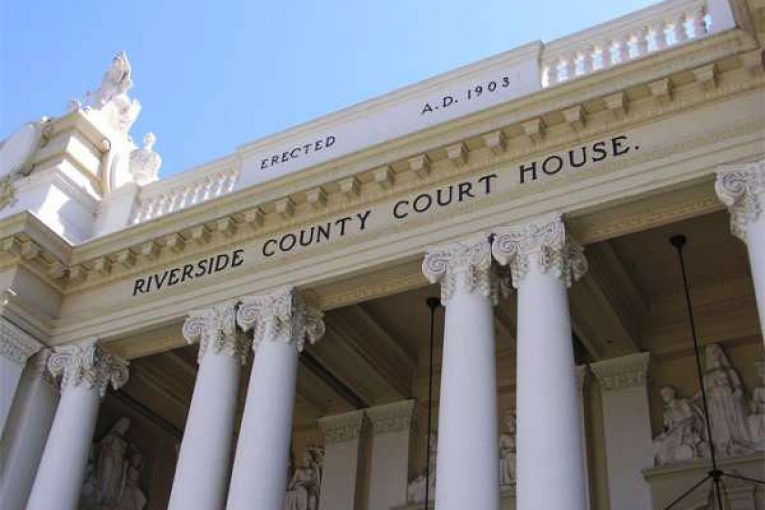

By Ozzy Hernandez and Brinda Kalita
INDIO, CA – The murder trial of Jose Vladmir Larin-Garcia resumed Wednesday here in Riverside County Superior Court / Larson Justice Center, with the defense claiming Larin-Garcia was framed and not guilty of four counts of first-degree murder, which could lead to the death penalty.
Before things officially went underway Wednesday, and out of earshot of the jury, there was a motion from the defense to add another expert witness, Randolph Beasley, who is a crime scene reconstructionist and analyst.
Deputy District Attorney Samantha Paixao disputed the defense could not prove another person was present in both scenes nor could another person other than Larin-Garcia could have perpetrated these crimes.
“No evidence of a third person in the backseat of the Toyota Corolla exists,” said DDA Paixao.
She added the expert’s testimony would be “irrelevant because it would not be based on evidence and it would not aid the jury in specifying where Larin-Garcia was seated in the back of the car.”
Defense Attorney Anthony Valente argued otherwise, and noted John Olvera’s testimony where he was called out for lying on the stand by the prosecution.
Olvera is the man the defense claims is the real culprit behind the quadruple murders.
The requested witness could provide the jury with new information that could “exonerate” his client, said Valente.
The motion was ultimately granted, with Judge Villalobos saying John Olvera is “all over the place” with his testimony and agreed with the defense’s statement to suggest there is another individual seen at the crime matching Olvera’s description.
It is unclear when Beasley will be available to testify.
Then, Blood Spatter Interpretation Specialist, Craig Odino, continued his testimony from the previous day.
DDA Paixao began by asking about the “point of origin” of the head shot of one of the victims. She presented images taken from the scene in conjunction with her questions.
When presented with one image in particular, Ogino confirmed the blood splatter originated from the back of Juan Duarte Raya’s seat.
Another photo presented was the origin of the blood spatter on the jacket. Ogino said it could only have been formed if the shooter was facing “directly toward Jacob Montgomery.”
Ogino noted the most important elements he looks for in blood spatter analysis are “size and direction, and angle” which he uses to determine points of origins and convergences.
During cross-examination, defense attorney Valente attempted to draw skepticism about Ogino’s findings and expertise which was met with constant objections from Paixao. Some questions were not answered.
After a lunch break, Defense Attorney Valente continued his cross examination of Ogino.
First, Valente asked Ogino if he knew the defendant’s jacket was zipped up. Ogino responded in the negative.
Second, Valente asked if the shooter’s jacket being unzipped could possibly have led to the blood splatters on the jacket not being able to reflect where the shooter was standing.
However, Ogino replied that the unzipping of the defendants jacket would not have changed the point of origin nor the point of convergence that he had calculated based on the bloodstains.
Valente redirected his attention to Beasley’s report. He asked Ogino a series of questions that attempted to connect Ogino’s findings to Beasley’s report of a third person being in the back of the Corolla. However, this line of questioning was met with constant objections from DDA Paixao.
Eventually, Judge Villalobos asked, “What is even the relevance? He (Ogino) is looking for high impact blood splatters but you are asking about windshields.” Attorney Valente answered the question by mentioning the importance of the bullet’s placement.
But Judge Villalobos restated how this was out of Ogino’s line of expertise, and that he is looking for high impact splatters. Nevertheless, he allowed Valente to continue this line of questioning on the bullets.
Valente continued to question Ogino about the placement of the bullet holes in the Corolla and whether it’s important to Ogino’s blood splatter analysis. Ogino replied that any of the bullets could cause the high energy splatter and it is difficult to tell from the exhibits being shown.
Defense Counsel Valente then asked Ogino if open windows can affect blood spatter and if he was aware that Montgomery and Duarte-Raya’s windows were open at the time of the shooting.
Ogino replied that “open windows can contribute to air resistance, which can change the direction of a blood spatter and can either prevent or encourage it to travel a great distance.”
In the redirect, DDA Paixao presented Ogino a photograph of four blood stains coming together at a convergence point.
Using this photo, Ogino revealed that since all the stains are perfectly pointing towards the origin, the car was not moving and no wind had affected the direction of the bloodstains.
DDA Paixao refocused her attention to Beasley’s reenactment and how it compared to Ogino’s findings.
Ogino first stated that Beasley’s removal of the headrest eliminated information that could have helped him find the point of origin of the bullet to the body.
DDA Paixao then asked Ogino if he could confirm how many people were in the backseat.
“I believe there were only two. Based on the point of origin, direction of travel of the high energy bloodstains on the jacket, and brown housing of the seatbelt, all of these indicate that there was a gap between the point of origin and the jacket and seatbelt. You physically cannot have three people in that backseat.” Ogino responds.
After Ogino’s statement, Attorney Valente attempted to weave holes into his analysis by asking if he was aware of the speedbumps on the route the Toyota drove or the speed of the car. Ogino replied that he was unsure if these factors could have affected his analysis of the blood stains.
The trial is set to continue Thursday at 1:30 p.m.
